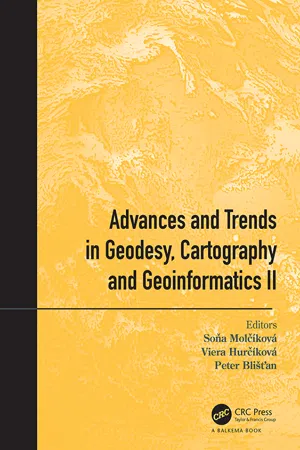
Advances and Trends in Geodesy, Cartography and Geoinformatics II
Proceedings of the 11th International Scientific and Professional Conference on Geodesy, Cartography and Geoinformatics (GCG 2019), September 10 - 13, 2019, Demänovská Dolina, Low Tatras, Slovakia
- 214 pages
- English
- ePUB (mobile friendly)
- Available on iOS & Android
Advances and Trends in Geodesy, Cartography and Geoinformatics II
Proceedings of the 11th International Scientific and Professional Conference on Geodesy, Cartography and Geoinformatics (GCG 2019), September 10 - 13, 2019, Demänovská Dolina, Low Tatras, Slovakia
About This Book
This volume contains a selection of peer-reviewed papers presented at the International Scientific and Professional Conference Geodesy, Cartography and Geoinformatics 2019 (GCG 2019). The conference provided a forum for prominent scientists, researchers and professionals from Slovakia, Poland and the Czech Republic to present novel and fundamental advances in the fields of geodesy, cartography and geoinformatics. Conference participants had the opportunity to exchange and share their experiences, research and results solved within scientific research projects with other colleagues. The conference was focused on a wide spectrum of actual topics and subjects areas in Surveying and mine surveying, Geodetic control and geodynamics and Cartography and Geoinformatics collected in this proceedings volume.
The Book Series "Advances and Trends in Geodesy, Cartography and Geoinformatics" is, in line with its long tradition, devoted to the publication of proceedings of peer-reviewed international conferences focusing on presenting technological and scientific advances in modern geodesy, geoinformatics, cartography, photogrammetry, remote sensing, geography, and related sciences. It plays an extremely important role in accelerating the development of all these disciplines, stimulating advanced education and training through the wide dissemination of new scientific knowledge and trends in Geodesy, Cartography and Geoinformatics to a broad group of scientists and specialists.
Frequently asked questions
Information
Surveying and mine surveying
Comparison of different measurement methods of crane runway
1 INTRODUCTION
2 CRANE RUNWAY

3 GEODETIC NETWORK
3.1 Accuracy analysis
Table of contents
- Cover
- Half Title
- Series Page
- Title Page
- Copyright Page
- Table of Contents
- Preface
- Committees of GCG 2019
- Surveying and mine surveying
- Geodetic control and geodynamics
- Cartography, geoinformatics and real estate
- Author Index
- Series Advances and Trends in Geodesy, Cartography and Geoinformatics